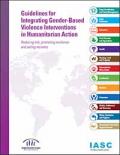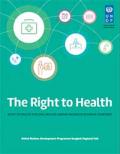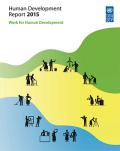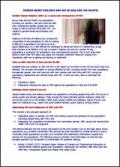What's New
Displaying results 2851 - 2860 of 4914

Resource | Guidelines,
Gender-based violence is among the greatest protection challenges individuals, families and communities face during humanitarian emergencies. Accounts of horrific sexual violence in conflict situations—especially against women and girls—have captured public attention in recent years. These violations and less recognized forms of gender-based violence—intimate partner violence, child marriage and female genital mutilation—are also being committed with disturbing frequency. Natural disasters and other emergencies exacerbate the violence and diminish means of protection. And gender-based violence not only violates and traumatizes its survivors, it also undermines the resilience of their societies, making it harder to recover and rebuild.
Despite the scope and severity of the problem, current programming to prevent gender-based violence and provide support for survivors is insufficient to deliver the desired results. The newly-revised Interagency Standing Committee (IASC) Guidelines for Integrating Gender-Based Violence Interventions in Humanitarian Action: Reducing risk, promoting resilience and aiding recovery are designed to address this gap, with clear steps the humanitarian community can take to protect people from gender-based violence.

Resource | Guidelines,
The strategies and action plans developed through consultations build on an increasing collaboration between the government and the civil society organizations, linking the facility-based health services with community level service provision by lay workers, and ensuring the quality of these services through extensive training and capacity building of the community-based organizations and service providers. Ensuring continuum of care between medical and paramedical health facility-based staff and outreach workers requires extensive training in new skills for these workers to be able to perform expanded tasks, adequate support by the health facility staff and smooth referral arrangements.

Resource | Publications,
The UNAIDS 2016–2021 Strategy is a bold call to action to get on the Fast-Track and reach people being left behind. It is an urgent call to front-load investments. It is a call to reach the 90–90–90 treatment targets, to close the testing gap and to protect the health of the 22 million people living with HIV who are still not accessing treatment. It is a call to redress the deplorably low treatment coverage for children living with HIV.

Resource | Publications,
This report provides a comprehensive situational overview of low-skilled labour migration and labour migration governance within South-East Asia, alongside a review of the legal, social, and cultural factors affecting the right to health for migrant workers in the region. An overview of the international standards for the right to health, including their specific application to migrant workers, is included as context for this situational overview.
At a global level, the catalyst for this report is the adoption of the World Health Assembly (WHA) Resolution on the Health of Migrants in 2008. Among other things, this resolution calls for the promotion of migrant-sensitive health policies;1 the establishment of health information systems containing disaggregated data to support analysis of migrant health needs; and the documentation and sharing of information and best practices for meeting the health needs of migrants in countries of origin, return, transit, or destination.

Resource | Publications,
To mark the twentieth anniversary of the Beijing Declaration and Platform for Action, the Economic and Social Council, in its resolution 2013/18, called on all Member States to undertake comprehensive national-level reviews of the progress made and challenges encountered in implementation of the Platform for Action.
In accordance with this mandate, the United Nations Economic and Social Commission for Asia and the Pacific (ESCAP) convened, in cooperation with UN-Women, the "Asian and Pacific Conference on Gender Equality and Women's Empowerment: Beijing+20 Review" from 17 to 20 November 2014 in Bangkok.
Occurring at the juncture between the conclusion of the Millennium Development Goals and the formulation of new global sustainable development goals, the Conference brought together more than 700 representatives from Governments, civil society and development partners from more than 50 countries, to address issues critical to achieving gender equality and women’s empowerment in Asia and the Pacific. These included reducing poverty among women, eliminating violence against women and girls, empowering women economically, increasing their political participation at all levels of government and addressing emerging environmental challenges.

Resource | Publications,
The 2015 Human Development Report is the latest in the series of global Human Development Reports published by the United Nations Development Programme (UNDP) since 1990 as independent, analytically and empirically grounded discussions of major development issues, trends and policies.
This report starts with a fundamental question - how can work enhance human development? The Report takes a broad view of work, going beyond jobs and taking into account such activities as unpaid care work, voluntary work and creative work - all of which contribute to the richness of human lives.

Resource | Publications,
Across Asia and the Pacific, key populations - including sex workers, men who have sex with men, transgender people, people who inject drugs, as well as persons living with HIV - are subject to gender-based discrimination and violence.
Violence or the fear of violence can increase the vulnerability of key populations to HIV by making it difficult or impossible to set the terms of an equal relationship. It is more difficult for individuals to refuse sex when in a relationship, to get their partners to be faithful, or to use a condom. Violence can also be a barrier for key populations in accessing HIV prevention, care, and treatment services. This in turn limits their ability to learn their HIV status and adopt and maintain protective measures ranging from negotiating safer sex to getting and staying on treatment.

Resource | Publications,
National AIDS Control Organisation (NACO), Ministry of Health and Family Welfare, Government of India periodically undertakes HIV estimations to provide the updated information on the status of HIV epidemic in India. The first HIV estimation in India was done in 1998, while the last round was done in 2012. India HIV Estimates 2015, latest round in the series, provides the current status of the HIV epidemic in the country and the states/ Union Territories (UTs) on key parameters of HIV prevalence, numbers of people living with HIV (PLHIV), new HIV infections, AIDS-related mortality and treatment needs.

Resource | Tools,
Implementing PrEP poses new challenges in planning, managing and funding combination prevention. Realizing the promise of PrEP will require governments, funders, civil society and other stakeholders to join forces to systematically address them–licensing antiretroviral medicines for PrEP use, setting priorities for locations and populations for implementation, making services user-friendly and ensuring adherence. These efforts are worthwhile based on their contribution to achieving the global targets of less than 500 000 people annually acquiring HIV in 2020 and the end of AIDS as a public health threat by 2030.

Resource | Publications,
The National AIDS Control Programme focuses on HIV education and prevention for the general population as well as specific at-risk groups, reducing the pool of undiagnosed HIV-infected individuals, and providing care and support to those living with HIV/AIDS. To further enhance the surveillance and control of HIV, MOH set up a National Public Health Unit in September 2008. This unit is responsible for maintaining and enhancing the National HIV Registry, carrying out contact tracing and partner notification for newly-diagnosed HIV patients, and conducting HIV-related public health research.
During the course of 2011 to 2014, national efforts to increase access to HIV prevention, education, testing, care and support have continued.





